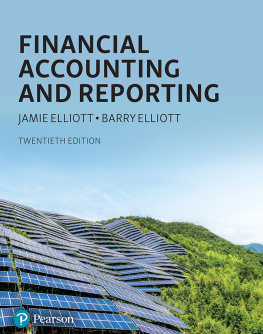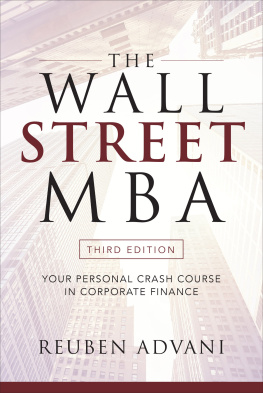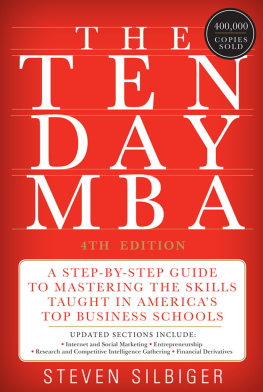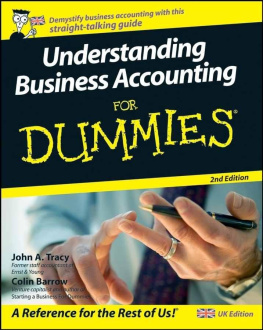After I earned my MBA, I had a chance to reflect on the two most exhausting and fulfilling years of my life. As I reviewed my course notes, I realized that the basics of an MBA education were quite simple and could easily be understood by a wider audience. Thousands of Ten-Day MBA readers have proven it! Readers are applying their MBA knowledge every day to their own business situations. Not only useful in the United States, The Ten-Day MBA has been translated into many languages around the world. So many people are curious about business education, including doctors, lawyers, businesspeople, and aspiring MBAs. This book answers their questions. The Ten-Day MBA really delivers useful information quickly and easily. Current MBA students have written me that they even use the book to review for exams. Ten-Day MBAs are walking the walk and talking the talk of MBAs every business day. Its proven that this book can work for you. Written for the impatient student, The Ten-Day MBA allows readers to really grasp the fundamentals of an MBA without losing two years wages and incurring an $80,000 debt for tuition and expenses.
Prospective MBAs can use this book to see if a two-year investment is worth their while; those about to enter business school can get a big head start on the competition; and those of you who cannot find the time or the money can get at least $20,000 of MBA education at 99 percent off the list price. Unfortunately, this book cannot provide you with the friendships and lifelong business contacts that you can develop at an elite school. However, it can impart many of the skills that make MBAs successful.
The Ten-Day MBA summarizes the essentials of a Top Ten MBA education. The mystique and the livelihood of the Top Ten business schools are predicated on making their curriculum appear as unique and complex as possible. Companies pay thousands of dollars to send their executives to drink from these hallowed fountains of knowledge for a few days. I spent two years of my life not only drinking from the fountain but also bathing and washing my clothes in it.
Which schools are included in the Top Ten is a subject of considerable debate, as displayed by the recent rankings shown at the end of this introduction. The Top Ten actually refers to a group of fifteen nationally recognized schools that play musical chairs for Top Ten ranking. They distinguish themselves by long application forms, active alumni networks, long lists of recruiters, and the ability of their graduates to demand and receive outrageous starting salaries. The Top Ten schools require of candidates at least two years work experience before admission. Experienced students can enrich class discussions and study groups. A great deal of my learning came from my classmates work experiences.
The Top Ten schools do not necessarily offer the best teaching, facilities, or curriculum. Reputation plays a great part in their status. A variety of rating books are available that give the inside story on those reputations. According to the 1998 Business Week poll, racking up the highest satisfaction scores from graduates are, in descending order, UCLA, Pennsylvania, Michigan, Cornell and Carnegie Mellon. The recruiters rankings, on the other hand, are Pennsylvania, Northwestern, Chicago, Columbia, and Michigan.
My aim is to cut to the heart of the top MBA programs subject matter clearly and conciselythe way only an MBA can, and the way academics would not dare. To cover the major concepts, I use examples and outlines and summarize wherever possible. I slice through the long-winded and self-serving academic readings that at times I had to trudge through. This book contains only the pearls of wisdom buried in my thirty-two binders of cases, course materials, and notes.
I have no vested interest in promoting any of the business theories presented in the book. Therefore, this book does not repeat the same idea over the course of two hundred pages as many popular business books have a tendency to do. I crystallize the most important concepts in brief passages so you can learn and remember them without losing interest.
From my interviews with graduates from Wharton, Harvard, Northwestern, and other top schools, I learned that all of their programs serve up the same MBA meal. Only the spices and presentations of the business banquets vary.
The basics of MBA knowledge fall into nine disciplines. Some schools have carefully crafted their own exalted names for each subject, but their unglorified names are:
Marketing
Ethics
Accounting
Organizational Behavior
Quantitative Analysis
Finance
Operations
Economics
Strategy
The synthesis of knowledge from all of these disciplines is what makes the MBA valuable. In the case of a new product manager with an MBA, she can not only see her business challenges from a marketing perspective, but she can recognize and deal with the financial and manufacturing demands created by her new product. This coordinated, multidisciplinary approach is usually missing in undergraduate business curricula. By learning about all the MBA disciplines at once, in one book, you have the opportunity to synthesize MBA knowledge the way you would at the best schools.
When MBAs congregate, we tend to engage in MBA babble. Our use of mystical abbreviations like NPV, SPC, and MBO is only a ruse to justify our lofty salaries and quick promotions. Please do not be intimidated. MBA jargon is easy to learn! As you read this book, you too will begin to think and talk like an MBA.
My goal is to make you familiar with the significant MBA tools and theories currently being taught at the leading business schools and to help you understand and develop the MBA mind-set. When you finish the ten days, please feel free to fill in your name on the diploma at the end of the book. It serves as evidence of your scholarship and you should proudly display it for all your friends to see.
Current MBA School Rankings
Below are the most current rankings of MBA programs. Although the rankings change from year to year, the same schools are consistently listed. School names listed in parentheses immortalize founders and major benefactors.
Two-Year MBA Degree Programs
U.S. News & World Report , March 1998:
1. Harvard
1. Stanford
3. Columbia
3. MIT (Sloan)
3. Pennsylvania (Wharton)
6. Chicago
6. Northwestern (Kellogg)
8. Dartmouth (Tuck)
8. UCLA (Anderson)
10. Virginia (Darden)
10. Berkeley (Haas)
10. Michigan
10. Duke (Fuqua)
(Several ties in rankings)
Business Week , October 1998:
1. Pennsylvania (Wharton)
2. Northwestern (Kellogg)
3. Chicago
4. Michigan
5. Harvard
6. Columbia
7. Duke (Fuqua)
8. Cornell
9. Stanford
10. Dartmouth (Tuck)
11. Virginia (Darden)
12. UCLA (Anderson)
13. NYU (Stern)
14. Carnegie Mellon
15. MIT (Sloan)
The Insiders Guide to the Top Ten Business Schools:
Chicago
Columbia
Dartmouth (Tuck)
Harvard
MIT (Sloan)
Michigan
Northwestern (Kellogg)
Pennsylvania (Wharton)
Stanford
Virginia (Darden)
This book by Tom Fischgrund (1993) provides excellent in-depth profiles of each school, written by graduates. Within the Top Ten, the schools are not ranked.
Nondegree Executive MBA Education








